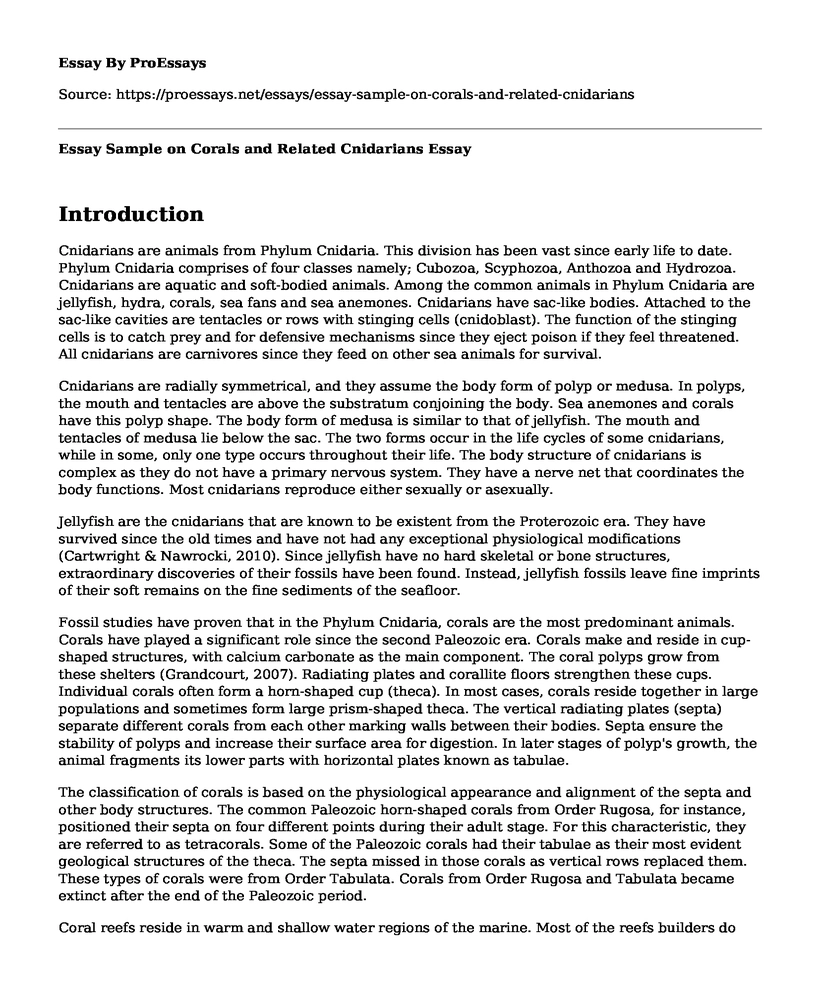Introduction
Cnidarians are animals from Phylum Cnidaria. This division has been vast since early life to date. Phylum Cnidaria comprises of four classes namely; Cubozoa, Scyphozoa, Anthozoa and Hydrozoa. Cnidarians are aquatic and soft-bodied animals. Among the common animals in Phylum Cnidaria are jellyfish, hydra, corals, sea fans and sea anemones. Cnidarians have sac-like bodies. Attached to the sac-like cavities are tentacles or rows with stinging cells (cnidoblast). The function of the stinging cells is to catch prey and for defensive mechanisms since they eject poison if they feel threatened. All cnidarians are carnivores since they feed on other sea animals for survival.
Cnidarians are radially symmetrical, and they assume the body form of polyp or medusa. In polyps, the mouth and tentacles are above the substratum conjoining the body. Sea anemones and corals have this polyp shape. The body form of medusa is similar to that of jellyfish. The mouth and tentacles of medusa lie below the sac. The two forms occur in the life cycles of some cnidarians, while in some, only one type occurs throughout their life. The body structure of cnidarians is complex as they do not have a primary nervous system. They have a nerve net that coordinates the body functions. Most cnidarians reproduce either sexually or asexually.
Jellyfish are the cnidarians that are known to be existent from the Proterozoic era. They have survived since the old times and have not had any exceptional physiological modifications (Cartwright & Nawrocki, 2010). Since jellyfish have no hard skeletal or bone structures, extraordinary discoveries of their fossils have been found. Instead, jellyfish fossils leave fine imprints of their soft remains on the fine sediments of the seafloor.
Fossil studies have proven that in the Phylum Cnidaria, corals are the most predominant animals. Corals have played a significant role since the second Paleozoic era. Corals make and reside in cup-shaped structures, with calcium carbonate as the main component. The coral polyps grow from these shelters (Grandcourt, 2007). Radiating plates and corallite floors strengthen these cups. Individual corals often form a horn-shaped cup (theca). In most cases, corals reside together in large populations and sometimes form large prism-shaped theca. The vertical radiating plates (septa) separate different corals from each other marking walls between their bodies. Septa ensure the stability of polyps and increase their surface area for digestion. In later stages of polyp's growth, the animal fragments its lower parts with horizontal plates known as tabulae.
The classification of corals is based on the physiological appearance and alignment of the septa and other body structures. The common Paleozoic horn-shaped corals from Order Rugosa, for instance, positioned their septa on four different points during their adult stage. For this characteristic, they are referred to as tetracorals. Some of the Paleozoic corals had their tabulae as their most evident geological structures of the theca. The septa missed in those corals as vertical rows replaced them. These types of corals were from Order Tabulata. Corals from Order Rugosa and Tabulata became extinct after the end of the Paleozoic period.
Coral reefs reside in warm and shallow water regions of the marine. Most of the reefs builders do not live beyond 15m. They prefer their temperature ranging from approximately 22C to 30C. The geographical location tends to restrict the reefs to latitudes between 30N and 30S. Algae and reefs share a symbiotic relationship with algae for nutrients and other supplementary functions (Wooldridge, 2010). This relationship proves the residence of reefs below 30m since algae need sufficient light for photosynthesis.
References
Grandcourt, E. (2007). Corals and coral reefs. Marine environment and resources of Abu Dhabi. Environment Agency (Abu Dhabi)/MotivatePublishing, Abu Dhabi, 118-161.
Wooldridge, S. A. (2010). Is the coralalgae symbiosis really 'mutually beneficial'for the partners?. BioEssays, 32(7), 615-625.
Cartwright, P., & Nawrocki, A. M. (2010). Character evolution in Hydrozoa (phylum Cnidaria).
Cite this page
Essay Sample on Corals and Related Cnidarians. (2022, May 16). Retrieved from https://proessays.net/essays/essay-sample-on-corals-and-related-cnidarians
If you are the original author of this essay and no longer wish to have it published on the ProEssays website, please click below to request its removal:
- Compare and Contrast Essay on ALF and PETA
- A Discussion on Respiratory System Paper Example
- Keeping Animals in Zoos Should Be Banned for Life - Essay Sample
- Plant Gene Breading and Human Gene Editing Paper Example
- Essay Example on Gastrointestinal Tract: Functions and Disorders
- Essay Example on Zoos and Aquariums: Protecting Animals and Improving Lives
- Speech Example on Harvest Time: Animal Slaughter in Barbara Kingsolver's Animal, Vegetable, Miracle







